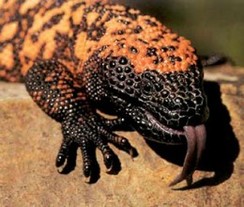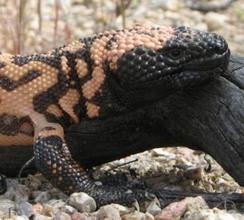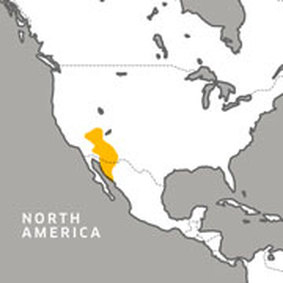Gila MonsterHeloderma suspectum |

Custom Search
|
|
The Gila monster (Heloderma suspectum) is a venomous species of lizard that inhabits the southwestern United States and the northwestern Mexican state of Sonora.
These monsters are found on dry-lands deserts and semi-deserts from the Southwest Utah to the west and south of Arizona and northwestern Mexico, from sea to 1500 meters (5000 ft) meters above sea level. During the warmer months of the year, they have nocturnal habits and hibernate in winter.Its name originated in the place where they were first found near the Gila River in Arizona. They may spend more than 95% of their lives inside their burrows, leaving to the desert only to feed, and they may go months between meals, or simply to warm themselves in the sun. The body fat is stored in their thick tails. These animals grow large and slow to a length of about 60 cm (24 inches), and they have a life expectancy of around 20 years in the wild, but may live up to 30 years in captivity. It has black, orange, yellow or pink bars, spots or blotches, with bands extending onto the tail. Its has a black face, and across its back small bead-like scales. It is one of only two venomous lizards found in North America, the other is the Mexican-beaded lizard (Heloderma horridum), is also the only venomous lizard native to the United states.
Although the Gila monster is venomous, its slow nature means that it represents little threat to humans. However, it has a fearsome reputation and is for that sometimes killed despite being protected by state law in Arizona and Nevada. Their venom is produced in the lower jaw while it is as toxic as that produced by the coral snake, due the fact of being produced in small quantities, is not considered very dangerous to humans. However, their bites can be incredibly painful, although they are thought never having caused death to any adult human.Today, we use a synthetic version of a protein that is found in the saliva of venomous Gila monster for the treatment of diabetes in humans. Furthermore, some other studies involving its venom may prove their venom's possible use in the treatment of Alzheimer's disease. While venomous snakes inject venom when they bite, the Gila monster bites hard, not letting go of the victim to give time for the neurotoxins to enter the blood stream through the open wound. In the case of a bite, the experts advise two methods to shake the lizard away from us: One is to plunge the creature into water, the other is making sure that the lizard is resting on the ground, the victim must lie motionless, the Gila monster will eventually open the jaws and go away. Gila Monster Diet The basis of feeding for these lizards consists of small rodents, such as rats and rabbits, eggs and carrion. However, it also feeds on the others lizards and occasionally birds. In captivity, them may be fed mice (previously killed or live), eggs, pieces of meat, but their diet must be supplemented with vitamins and calcium. Wild Gila monster lizards caught in their natural habitat may refuse food and die. It uses his tongue to feel the scents left in the sand by other animals and capture their prey. Gila monster Reproduction They reach sexual maturity at 4 to 5 years old and have their mating season in late spring to summer, from the months of April to July. The species has an incubation period of up to 10 months. The females of the Gila monster lizard species make a hole in the sand where they lay up to 12 eggs, which hatch about 30 days later. The young are born with about 16 cm (6,5 inches) long and are able to bite and inject venom soon after hatching. The reproductive cycle of females seems to be related to the amount of food and minerals stored in their body. When the reserves are low, they do not attract males to mate and remain without reproducing. Gila Monster Conservation status and main threats The Gila monster is listed by the IUCN as near threatened. Vulnerable and protected by federal law in the United States, where the hunting or harassing is prohibited. Unfortunately, their population numbers are threatened, due to increased human constructions around the North American desert area, and also by the consumption of their meat, which supposedly has aphrodisiac effects. On the exotic pet black market, they are sold at exorbitant prices.
|
Scientific classification
Kingdom: Animalia Phylum: Chordata Class: Reptilia Order: Squamata Superfamily: Varanoidea Family: Helodermatidae Genus: Heloderma Species: H. suspectum |



